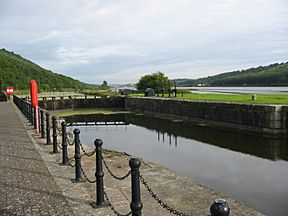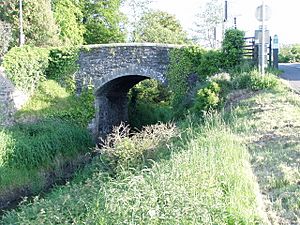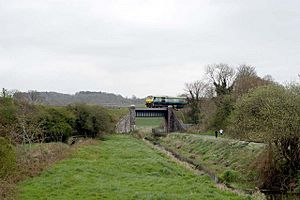Newry Canal facts for kids
Quick facts for kids Newry Canal |
|
|---|---|

Victoria Lock at the entrance to Newry ship canal in Carlingford Lough
|
|
| Specifications | |
| Maximum boat length | 13.4 m (43 ft 11.6 in) |
| Maximum boat beam | 15.47 m (50 ft 9 in) |
| Locks | 14 (originally 13) |
| Original number of locks | 13 |
| Maximum height above sea level | 23.8 m (78 ft) |
| Status | abandoned |
| History | |
| Principal engineer | Edward Lovett Pearce, Thomas Steers |
| Date completed | 1741 |
| Date closed | 1949, 1970s |
| Geography | |
| Start point | Newry |
| End point | Portadown |
The Newry Canal is a historic waterway in Northern Ireland. It was built to connect the coalfields of Tyrone to the Irish Sea. This connection was made through Lough Neagh and the River Bann. The canal reached the sea at Carlingford Lough, near Newry.
This canal was special because it was the first "summit level canal" in Ireland or Great Britain. A summit level canal crosses the highest point between two valleys. It uses locks to lift boats up one side and lower them down the other. The Newry Canal was built almost 30 years before the famous Bridgewater Canal. It was also 15 years older than the Sankey Canal. The government paid for its construction. It officially opened in 1742.
However, the canal had some early problems. The locks were not built perfectly. The highest part of the canal was too narrow. There were also issues with getting enough water. Later, a larger ship canal was built below Newry in 1769. This helped Newry and the canal become very busy.
Around 1800, the canal was in bad shape. The government spent a lot more money to fix it. This work took about ten years. During the repairs, the canal often closed. This made boats use roads instead. Traffic on the canal never fully returned to its old levels. In 1829, private companies took over both canals. They spent even more money to improve them. The ship canal was made bigger in 1884. This allowed very large ships to reach Newry.
The canal went back to public ownership in 1901. A new group, the Newry Port and Harbour Authority, was formed. The Newry Canal stopped being used for trade in 1936. Most of it was officially closed in 1949. The ship canal closed in 1966. The Authority was shut down in 1974.
Today, parts of the old canal have been bought by local councils. The ship canal is now open for pleasure boats. There have been efforts to reopen the Newry Canal itself. These plans have not yet worked out. The path next to the canal, called the towpath, is now a walking and cycling route. It is part of the National Cycle Network. Some parts of the canal have been restored. It has become a home for many types of wildlife. People also enjoy fishing there.
Contents
Building the Newry Canal
People wondered about a water route from Lough Neagh to Carlingford Lough for a long time. This idea came up even before the 1640s. During Oliver Cromwell's time in Ireland, a survey was done. An order was given to dig a canal from Portadown to Newry. But no work was ever started.
Later, in 1703, another survey was made. Still, nothing happened. Then, coal was found in Tyrone. People really wanted a way to get this coal to Dublin. In 1715, a law was proposed to improve transport. But it did not pass. People realized that local areas could not pay for or manage such big projects.
To help with this, the Irish Parliament offered a reward in 1717. They would give £1,000 to the first person to bring 500 tons of Irish coal to Dublin. In 1729, the Commissioners of Inland Navigation for Ireland were set up. This group included important government officials and others. They would manage all inland waterways.
The Commissioners hoped that Tyrone coal could make Dublin self-sufficient. Dublin often had to buy coal from Great Britain. This supply was not always reliable. So, the canal project was approved. Work did not start right away. Thomas Burgh, a government official, owned coal mines elsewhere. He did not want Tyrone coal to become widely available.
Burgh died in 1730. Edward Lovett Pearce took over his role. Work on the canal began in 1731. Pearce was busy building the new Parliament House. So, he gave the canal job to his assistant, Richard Cassels. Cassels had studied navigation in other countries. He was a skilled architect.
Pearce died in 1733. Cassels then became the main engineer for the canal. He built the first navigation lock in Ireland. But he was fired in 1736. He was spending more time on his architecture jobs. Thomas Steers replaced him. Steers hired a local man, William Gilbert, to oversee the work. The canal was finished by 1741.
Legal problems delayed the official opening until 1742. On March 28, 1742, a barge full of coal reached Dublin. The coal had to travel overland to Lough Neagh first. This was because the Coalisland Canal, which connected to Lough Neagh, was not yet finished.
The Newry Canal has 14 locks. Nine of these locks are south of the highest point. This highest point is about 23.8 meters (78 feet) above Carlingford Lough. The locks are 13.3 meters (43.6 feet) long and 15.5 feet (4.7 meters) wide. They were 12 to 13 feet (3.7 to 4 meters) deep. In the early 1800s, the original brick sides of the locks began to crumble. They were then covered with stone from local quarries.
In 1750, the canal manager reported problems. The locks were faulty, and there was not enough water. The highest section was too narrow. Despite this, Newry merchants wanted to make their town a better port. They got money from the government to build a ship canal. The first builder was fired. Thomas Omer took over as engineer. Omer built a 3.2-kilometer (2-mile) ship canal. It could hold boats up to 120 tonnes.
Newry became a busy port after the ship canal was finished in 1769. Trade also grew on the Newry Canal. It mostly carried grain and other goods, not coal. The canal also helped the linen industry and butter production in Tyrone.
How the Canal Operated
Even with its problems, the canal earned about £7,000 a year from tolls by the 1790s. But local people were running the canal. They did not spend money to fix or maintain it. By 1800, it was falling apart. The Director General took control. An engineer named Henry Walker was asked to fix it. But he was caught doing something wrong and sent away.
Then, John Brownrigg wrote a detailed report. He said it would be cheaper to build a new canal than fix the old one. But his advice was ignored. The repairs involved rebuilding bridges and locks. They also widened and deepened the highest part of the canal. This meant the canal was closed for long periods. The water supply was improved, and the ship lock was fixed. But because of the closures, traffic moved to roads. It was hard to get it back to the canal after the work finished in 1811.
Between 1818 and 1827, the canal collected about £2,546 in tolls each year. Its savings grew. If you ignored the money the government spent, the canal made a small profit. In 1813, William Dawson started a private passenger service. It ran from Portadown to Newry. This service continued for many years.
The Tyrone Navigation finally opened in 1787. But this did not bring coal traffic to the Newry Canal. Newry's importance as a port also decreased. Belfast became more important. The ship canal was too small for the new, larger steamships. Engineers suggested building a bigger sea lock in deeper water. They also said the ship canal needed to be enlarged.
In 1829, the government agreed to give both canals to a private company. This company promised to spend £80,000 on improvements. They kept their promise. By 1850, a new sea lock was built. It was about 1.5 miles (2.4 kilometers) further down the estuary. This allowed ships twice as big to use the canal. The river was deepened, and a new basin was built at Newry. The Newry Canal also benefited. Its income rose, and the amount of goods carried doubled.
The Canal's Decline
When railways arrived in the 1850s, the canal started to decline. A railway line from Belfast to Dublin opened in 1852. It ran next to the canal for much of its length. Newry got its own short railway line. In 1865, a link from Newry to Armagh was finished. Newry continued to do well as a port. The amount of goods passing through it more than tripled. But traffic on the canal itself was cut in half.
The company that owned the canal still had debts from earlier projects. Coal traffic from Tyrone had almost stopped. Still, some goods were carried on the canal. Most of this traffic went north from Newry. It included imported coal, wood, and heavy items. For these goods, the canal was still cheaper than the railways.
In 1884, the company did its last major project. They made the upper parts of Carlingford Lough and the lower Newry River deeper. The channel was also widened to 120 feet (36.6 meters). This allowed ships up to 5,000 tons to reach Newry. This project cost £55,000.
There were plans to extend a railway line to Newry in 1900. But the canal company would have objected. Relationships between the canal company and Newry Urban Council were already difficult. So, the railway plan was dropped. Instead, the railway promoters and the council worked together. They planned to buy the canal company. They wanted to create a public group to manage the port and town's interests.
The Newry Port and Harbour Trust was created in 1901. The Newry Canal made a small profit until World War I. After the war, maintenance costs became too high. The last commercial boat used the canal in 1936. The government in Northern Ireland was not interested in canals. So, most of the canal was officially closed in 1949. The Newry town section closed in 1956. Soon, the swing bridges in Newry were replaced with fixed bridges. This cut off the canal from the sea. The ship canal closed in 1966. The Newry Port and Harbour Trust was shut down in 1974.
Restoring the Canal
People in charge of selling the Trust's assets contacted local councils. Newry and Mourne District Council bought the ship canal and part of the Newry Canal for two pounds. Craigavon Borough Council bought the northern part for another two pounds. The middle section was given to Armagh City and District Council and Banbridge District Council in 1992.
The Newry Canal was one of the first waterways in Northern Ireland considered for restoration. A plan was made in 1980. In 1996, there was an attempt to get lottery funding. But it failed because they could not find matching funds. The plans involved using most of the old canal route. But they would bypass the fixed bridges in Newry. This would involve using the Clanrye River and building new locks.
Moneypenny's Lock (Lock No. 14) has been restored. It was named after the lock-keepers who lived there for over 80 years. Craigavon Borough Council restored it. Banbridge District Council has a small museum at Scarva. Newry and Mourne District Council restored the ship canal and sea lock. Now, leisure boats can visit Newry. It can handle boats up to 61 meters (200 feet) long and 10 meters (33 feet) wide. They can have a depth of up to 3.4 meters (11 feet). Victoria Lock, where the ship canal meets the sea, is affected by tides. It became automated in May 2007.
Since its closure, some parts of the canal have fallen into disrepair. Most of the lock gates have rotted away. But many of the locks themselves are in great condition. They were built from strong local granite. The canal is now overgrown in many places. This means it is a wonderful home for wildlife.
Animals like otters live there. The Brackagh Bog area has special plants and insects. These include damselflies, dragonflies, and 19 types of butterflies. Fresh water flows through the canal. There are also many fish. You can go coarse fishing for perch, roach, bream, and pike. This is possible on the River Bann, the ship canal, and parts of the canal. However, the lower sections are full of weeds.
The towpath has been reopened. Two wardens maintain it all year. It is now part of the Ulster Way long-distance walking path. It is also part of the National Cycle Network's National Cycle Route 9. This route will eventually connect Belfast with Dublin.
Getting to the Canal by Railway
The Belfast–Newry railway line helps walkers get to the canal. You can use the NI Railways stations at Portadown, Scarva, and Poyntzpass.



